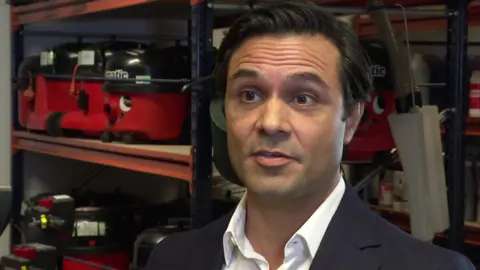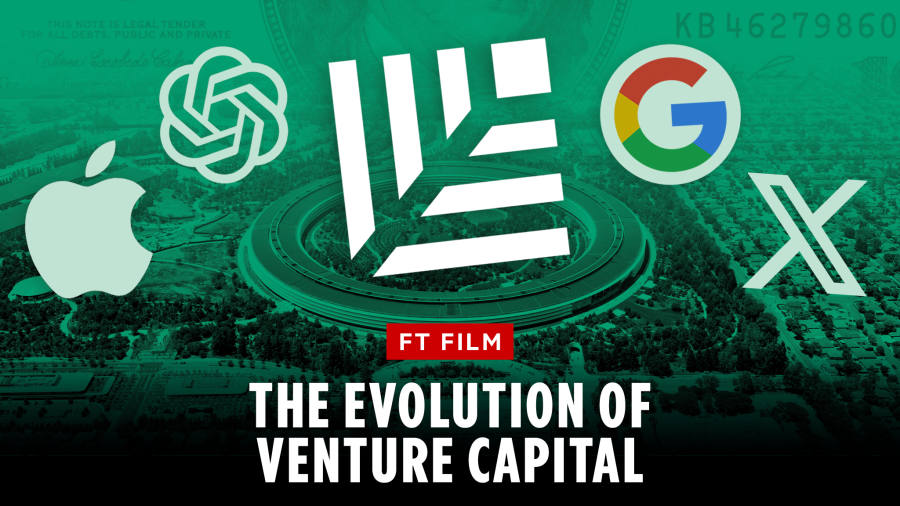You can enable subtitles (captions) in the video player
[MUSIC PLAYING]
TABBY KINDER: Sequoia, like a lot of firms in Silicon Valley, is facing this really pivotal, transformational moment.
SEBASTIAN MALLABY: In any downturn, it’s going to be painful for everybody.
TABBY KINDER: And it’s a really important moment for firms like Sequoia, because they have held this gold standard of VC for so long.
GEORGE HAMMOND: It’s a story about Sequoia, but it’s a story about venture capital. It’s a story about how the industry has grown, and it’s going to have to shrink.
SEBASTIAN MALLABY: When you invest in startups, it’s going to be rock and roll. It’s going to be a bumpy road. It’s not a smooth thing. This is an active, gloves off, combative form of investment.
ORTENCA ALIAJ: Why Sequoia itself is important is because it embodies the VC industry and who Silicon Valley is.
TABBY KINDER: Sequoia Capital is one of the most venerated venture capital firms in Silicon Valley. It’s 50 years of investing expertise, investing in early stage companies, and betting that some of those companies will become unicorns worth over $1 billion or become even more successful listed companies.
GEORGE HAMMOND: The firm has invested in Apple, Oracle, Cisco, Atari, Google, Yahoo, PayPal, Airbnb, and YouTube, and Instagram, and OpenAI.
BROOKE MASTERS: Companies they backed right now make up 25% of the NASDAQ, which is the tech-heavy index. That just tells you just how crucial they have been to the growth of technology and innovation in the US.
TABBY KINDER: Venture capital is the backbone of the Silicon Valley ecosystem. It’s how companies like Google, like Facebook are founded, essentially.
ORTENCA ALIAJ: And it has the good sides, which is that it’s fueling this new technology. But there are also the bad sides, not just of Sequoia, but of VC investing, which encourages this sort of fake-it-until-you-make-it attitude amongst entrepreneurs. And that’s where you can have big problems like Sam Bankman-Fried and FTX.
GEORGE HAMMOND: Before artificial intelligence captured the imagination of every investor in Silicon Valley, cryptocurrencies with a major boom and the major area of focus.
LARRY DAVID: Eh, I don’t think so. And I’m never wrong about this stuff. Never.
GEORGE HAMMOND: And Sequoia were not one of the earliest into crypto. They were a little bit sceptical as investors compared to some of their major rivals. Andreessen Horowitz, one of their biggest rivals, really went full speed ahead into crypto– so quite a setback.
And then when it seemed like crypto was really going up and up and up, they decided to make a big investment into a cryptocurrency exchange called FTX. And they invested $225 million in 2022.
ORTENCA ALIAJ: At the time, Bitcoin was one of the most popular assets. And there was not a clear-cut way for big investment firms to go into cryptocurrency. So once SBF, if I can call him that, came into the scene, that was when people started to legitimise the business. He was seen as this person who was going to institutionalise cryptocurrencies. And, of course, the opposite ended up happening.
TABBY KINDER: The question after FTX failed was, really, how a firm like Sequoia, with so much experience, 50 years of investing expertise, some of the best venture capitalists in the business working at that firm, how they could have got it so wrong and what that says about the diligence done by VC funds over their investments more generally.
REPORTER 1: Venture capital powerhouse Sequoia telling investors this morning that it’s splitting up into three separate and independent partnerships.
GEORGE HAMMOND: In the last few years, Sequoia has undergone more changes in a shorter amount of time than it has done probably at any other point in its history. Perhaps the most prominent of those was the separation of Sequoia’s US, and European, and Chinese, and Indian businesses.
TABBY KINDER: Sequoia was one of the biggest and boldest entrants to China by a Silicon Valley VC firm. It set up this huge fund. It employed Neil Shen, one of, really, the best start investors in China, to launch its China practise. And for the last couple of decades, it really has had, of all the Silicon Valley firms, the best and largest China presence.
GEORGE HAMMOND: They made the decision to split the firm. It’s a major decision. This was a venture capital firm who was more globally expansive than any other, who was more successful at being globally expansive than any other. They’re retrenching in a very meaningful way.
And, simultaneously, they carved out their Indian operations. And so now what was this massive global business is a US and European-focused entity– so very different in its outlook, in its focus, in its investment area, and a much smaller firm than it was. The Chinese business was managing more than $50 billion in capital.
And so that is now a distinct entity called Hongshan.
TABBY KINDER: Sequoia US, which is now Sequoia, they own some Chinese companies still. So Sequoia is still an investor in ByteDance, which is a really interesting investment for it, given that TikTok is facing a ban in the US.
BROOKE MASTERS: ByteDance is a really important investment for the firms that are in it because it owns TikTok, which is this wildly successful video site that is incredibly popular with young people, many investors believe is the future, or at least the near future, for advertising and social media. And so if ByteDance is forced to sell TikTok, it’s not clear how that’s going to affect ByteDance’s shareholders.
SEBASTIAN MALLABY: There’s been these series of well-publicised setbacks– ironically, well-publicised because Sequoia is so good. And I would tend to view these setbacks, I’m talking about the FTX investment, I’m talking about having to cut off the China business because of the geopolitics– and I think what determines the future for Sequoia is how skillfully they capture the next technology wave.
REPORTER 2: The area also supports a variety of light and heavy industries. Investment capital from the city and other parts of the country supports hundreds of pioneering high technology companies in the so-called Silicon Valley, just south of the city.
[EASY MUSIC PLAYING]
GEORGE HAMMOND: Conceptually, it emerged in the 1970s. And it’s called Silicon Valley because of the enormous amount of silicon required to power the semiconductor industry. And it has really been the epicentre of US technology and global technology.
SEBASTIAN MALLABY: In the 1950s and ’60s, Arthur Rock, a financier from New York, showed up in what was then just the Santa Clara Valley, not Silicon Valley, and financed Fairchild Semiconductor, which kickstarted the tech ecosystem on the West Coast. And it was that introduction of risk capital which turned a bunch of disparate engineers into a bunch of people who actually formed a company.
Right at the beginning of the venture capital story on the West Coast, Arthur Rock set up an office right in San Francisco downtown. But the second wave in the 1970s, Kleiner Perkins, Sequoia, clustered around the Stanford campus, and particularly on Sand Hill Road. And there was a real estate developer at the time who opened up some new office space on Sand Hill Road and made these people welcome. And so it began a tradition.
ILYA A. STREBULAEV: So if I ask you, what are the largest companies that were created in the last 50 years, OK? Well, that would be, you can say Apple and FedEx, OK, all happened just at that point in the 1970s, and it coincided with the rise of the venture capital industry. OK?
And, moreover, I mentioned the ERISA Act, which, effectively, allowed pension fund money and then other money to flow in into riskier assets. And, by the way, from the very beginning, it was not just in Silicon Valley. It was also in Massachusetts.
It was also, at some point, in North Carolina. But Silicon Valley became, very quickly, the hotspot of the venture capital industry.
SEBASTIAN MALLABY: Of course, it helps in California that non-compete laws could not be enforced. And, therefore, you could pull somebody out of one company, put them into a new company. They would leave one company on a Friday, and on Monday morning, there they are in the new company.
That would have been illegal in Massachusetts. But what differentiated the two was that you had much more aggressive venture capital on the West Coast.
ORTENCA ALIAJ: Sequoia Capital was started in the early-1970s by Don Valentine. He was sort of seen as this very kind of humble person. He is amongst the few who hasn’t named his company after himself.
SEBASTIAN MALLABY: He had been a water polo player and had the physique to go with that. And he’d been a semiconductor salesman as well. And because he’d been on the sales side, he chose to specialise not necessarily in really cutting edge technology, but in the commercialization of existing technology.
And so, often, the people he backed were kind of crazy business people like Steve Jobs doing Apple, the crew who did Atari, the early game company, that did games like Pong– you walked into their factory, and everyone would get high just from walking around because people were just smoking dope on the production line. These were some pretty wacky founders.
And Atari, for example, would say to their investors, if you want to talk to us, you have to come in this hot tub– take your clothes off and sit in this hot tub. And the good thing about Don Valentine was he wasn’t frightened. And when he took his shirt off, because of that water polo playing I told you about, his authority went up, not down.
And so he was able to look at these crazy founders in the eyes and say, listen, you’re going to take it from me. You’re doing something wrong here. Do it this way, not that way. So he pioneered a hands-on model of venture capital investing, which became central to the model later on.
ORTENCA ALIAJ: Don Valentine had this idea that he didn’t want your classic Harvard Business School graduate to join the firm. He wanted to venture out of that, for want of a better word, and find people who were kind of wonky. And the two people he found who eventually ended up co-leading the firm were, actually, extremely different from each other. So you have Michael Moritz, who’s this Oxford-educated guy who then moves to America to work as a journalist for “Time” magazine.
SEBASTIAN MALLABY: Don Valentine’s sort of tough guy style of almost boasting about firing company founders, when capital becomes more plentiful, then all the capitalists have to compete to be charming to the startup founders. And threatening them with being fired became a very bad business idea.
And so it’s fitting that Michael Moritz, who had a smoother style, became, basically, the number one after Don Valentine retired. Doug Leone is a slightly different character, much more of a sort of tough guy– again, he once boasted to me that he went to the dentist and had his tooth drilled without anaesthetic just to prove he was tough enough to withstand the pain.
He had an unbelievable work ethic. He was famous for just relentlessly following up, doing calls at 5:00 in the morning, at midnight at night, getting on planes to China the whole time.
GEORGE HAMMOND: Sequoia have managed to have success over generations. Don Valentine founded Sequoia in 1972. He hands over the reins to Mike Moritz and Doug Leone in 1996.
Roelof Botha joins Sequoia in 2003. He’s hired by Michael Moritz, who at that point is managing partner of Sequoia. And he rises through the ranks. He’s invested in various very successful companies, including YouTube, MongoDB. And he becomes the managing partner of the US and European business in 2017. And in 2022, he steps up to lead the whole firm. This is the global business as was before it split off.
BROOKE MASTERS: Sequoia, like many other great investment firms founded in the 1970s, has been undergoing generational change. Where the founders and the early success stories are getting older. They’re moving on. And they are having to transition to different leadership.
And, in many places, it’s been quite bumpy. It’s complicated. That doesn’t mean they won’t come through with great success. It’s just generational change is awkward.
GEORGE HAMMOND: One incident that brought that to light was a board level conflict at Klarna, which is one of Sequoia’s biggest European investments. It’s a buy now, pay later company. It was once Europe’s most highly valued startup.
Effectively, what had happened was that Sequoia’s partner on the board, a man called Matthew Miller, had tried to remove Sequoia’s former managing partner, Michael Moritz, who remained as the independent chairman of Klarna– had tried to move against him and have him removed from the board.
TABBY KINDER: Former partner Mike Moritz, one of the biggest veterans investing in Silicon Valley, when he left the firm last summer, he maintained a board seat at Klarna and at many of the other companies where he had led Sequoia’s investments and had become very close to the founders of those companies over time.
ORTENCA ALIAJ: You almost have the physicality of the old guard, the new guard butting heads. And, of course, this spills out into the open. And it also emerges that Matthew Miller did this with the knowledge and backing of Sequoia, which stings even more for Moritz. And, eventually, I think Sequoia see that this has become a public relations disaster. And even though they say, we’ve resolved this, we don’t want to hear any more about it, this becomes another episode, which, I think, starts to make investors feel uncomfortable about what exactly is going on at Sequoia and why this fabled firm is suddenly having these boardroom scraps with former and current employees.
TABBY KINDER: This new generation of venture capitalists at Sequoia have already made some very bold and large bets. Roloff was really fundamental in Sequoia making an investment in Twitter when Elon Musk took it private. And Roloff used to work with Musk at PayPal. They’re very close. Sequoia has other links to Elon Musk.
GEORGE HAMMOND: That has been part of the reason why Sequoia has invested in multiple of Elon Musk’s ventures, including his tunnel-digging company, the Boring Company, his rockets company, SpaceX, and, more recently, Sequoia put $800 million into Elon Musk’s acquisition of Twitter in 2022.
TABBY KINDER: So far, we just don’t know how successful that investment is going to be. I mean, Twitter is now valued at a fraction of the price that Elon Musk paid for it. What we don’t know is how successful Elon Musk will be in turning Twitter around. And if he can turn it into a successful profit-generating business again, then it will be a rosy investment for Sequoia. But at the moment, it looks very uncertain.
GEORGE HAMMOND: Sequoia struck gold on a number of early investments. So its first investment was Atari, some other very notable investments Apple, Google, these companies which became absolutely huge and, in quite short order, returned huge amounts of money for Sequoia and its own investors. And once it had done that, particularly in the world of venture capital as it was, which was more of a cottage industry 30, 40 years ago, certainly, Sequoia had an incredible brand on which to trade.
And once you have that brand, every start is going to think, right, this is the venture capital firm that I want investment from, because as soon as I have this logo on my company, others are going to think, this is a serious startup, and we should take them seriously.
YASMEEN BUTT: Right now, we are hosting a tech weekend, which is a three-day event. We do this every five weeks. 200 to 300 founders come over from different states and different countries. The VC mixer idea was that just easy access to VCs in a very short period of time in a location. And we also kept it very transparent. We told people exactly which funds are coming.
NATHAN BECKFORD: So, is it a dream to be funded by the Sequoias of the world? Yes. That’s an easy softball question. Yes, it is. I mean, the credibility that comes from being funded by a Sequoia, or Kleiner Perkins, or Andreessen Horowitz is huge.
It’s a nice stamp of credibility on your vision. It helps you with recruiting. And it helps you with finding co-investors, right? Everyone wants to do a deal with Sequoia, so you’re going to have a lot of other choices and options as a founder if you’ve got Sequoia on your cap table or leading around.
ARMAAN SAINI: I’m not going to lie that everybody’s ideal goal is to get funded by a tier one– Sequoia, Andreessen Horowitz, General Catalyst. And so funds like this, they have deep relationships, pockets, and can really help your business along.
FARID FADAIE: You need that X factor that helps you grow. That X factor could be the fame of the VC– because if they invest, oh, Sequoia invested in you, there should be something about it. Let’s test it. Because they have a big network, they have a brand recognition– even just them investing in your company will give you a boost.
NATHAN BECKFORD: One of the common themes and common responses I get from founders is, optimise for the best fit with the investor, not necessarily the brand name, or valuation, or terms. You’ve got to find the investor that you can work with and that is going to help you.
And that isn’t always the big brand firms. Some of the newer venture funds are hungry. They’re going to work a little harder, maybe, to build their brands because they’re unproven. And that can be a good choice, too.
So, yes, you still want to take a check from Sequoia if you can. But if they’re not the best fit for you, that’s OK, too.
GEORGE HAMMOND: When Sequoia was founded, venture capital was really a cottage industry. It was a few dozen firms. In the last 10 or 15 years, the number of venture capital firms in the US has quadrupled. And Silicon Valley has been the epicentre of that, but now Austin, New York, other parts of America also have a real ecosystem. And that has completely changed the nature of the market.
SEBASTIAN MALLABY: If you’re a venture capitalist, it’s much, much bigger than it used to be. And it’s gone global at the same time. So it makes sense that there should be more venture capitalists with more money. But, of course, it’s also possible that there could be too many, that even though the opportunity set has grown, let’s say it’s multiplied by 10, if you multiply the number of venture capitalists by 20, you’ve got a problem.
You’ve got too many investors chasing too few deals. They’re going to bid too hard to get into the deals. They’ll overprice the deals. And then you’ll have a bubble. And we’ve just seen one.
BROOKE MASTERS: There’s been a real shift since 2021 for the venture capital industry. Back then, everyone had money to invest from investors and was just throwing it at companies. Since then, with higher interest rates, investors have become more sceptical about handing their money over to venture capital because they can get good returns with a lot less risk.
At the same time, the IPO and M&A markets have been largely closed, making it hard to get money out of venture capital and back to investors. So those two things have combined to mean that many venture capital firms have much less money to invest and many less profits to show. So it’s a really challenging time.
TABBY KINDER: Venture capital has, for decades, been a really elite form of investing. And it’s been considered to be quite closed. It’s difficult to get in. Venture capital firms take all of their money from institutional investors like pension funds, university endowment funds.
But in the last few years, there’s been a sort of widening of the industry where big public investors, like, for example, Tiger, SoftBank, come in and create venture capital funds to put money to work in private startup companies.
ORTENCA ALIAJ: I think it’s important to note that Sequoia’s business, the nature of its business, at least, changed with the rise of firms like SoftBank, because you are trying to get a good valuation on the business. And if you have a behemoth like SoftBank just throwing money at these companies at insane valuations, it’s very hard to compete.
So either you miss out on what could potentially be a good investment because you’re not willing to match that valuation, or you go along with it and you become part of this bubble where the valuations keep getting bid up. And we’ve seen how that’s played out, right? It hasn’t played out great for companies as the interest rate environment has changed.
ILYA A. STREBULAEV: These days, there is more competition, a lot more investors, there is a lot more money at play. Also, it’s easier to enter the market.
Venture capitals nowadays compete both with corporate venture capital funds. They compete with sovereign wealth funds and mutual funds in late stages. They compete with micro VC funds, with angel investors at the early stages. And so this, I think, gives rise to some behaviour that is challenging.
ORTENCA ALIAJ: I think FTX was driven by the FOMO, the fear of missing out, mentality. And at the time, Bitcoin was one of the most popular assets. And there was not a clear-cut way for big investment firms to go into cryptocurrency.
BROOKE MASTERS: Stories like what happened with FTX, where it turns out to have been a complete fraud, grow out of this environment where every one of the entrepreneurs, or certainly a huge number of them, are overstating what they are going to be able to accomplish. And the venture capitalists kind of bake that in.
It makes them a little bit vulnerable to actual out and out frauds, because they know even the best companies, run by the entrepreneurs who are really smart, probably are slightly overstating. And so their scepticism is built into their model, which is that they don’t expect all of these companies to come good. So they don’t need to actually check that every single one is as legitimate or living up to its claims.
GEORGE HAMMOND: For Sequoia, losing $225 million in the context of their gains elsewhere, is manageable. But reputationally, it was a blow. Because it was Sequoia, because it was this storied 50-year-old firm who didn’t make mistakes, who were very smart, very savvy, and quite cautious, they put their hands up and said, we made a mistake. And they’ve tried to move on from it.
But it coloured their cryptocurrency investment strategy. And I think for some investors in the firm, it was, for the first time in a long time, just a question mark over some of the decision making at Sequoia.
BROOKE MASTERS: Venture capital investing is a little bit like throwing darts at a dart board. You do not expect all your bets to come good. A successful venture capital firm might back 100 firms, of which only 10 are profitable, and of those 10, one makes it enormous.
But they expect a lot of failure. So it’s built into their model. And so when they back companies, they know that a lot of them aren’t going to come good. They just don’t know which one is going to be the star.
SEBASTIAN MALLABY: There’s a temptation where people say, oh, look, three things went wrong. Three things make a trend. Oh, there must be some systemic crisis here.
But, really, the three things that one could point to are pretty much unconnected, right? There was a geopolitical rift between the US and China, so Sequoia needed to separate the China business from the US business. And that’s just politics. That’s global politics.
It’s nothing to do with bad investments or whatever. Then, you’ve got a massive crypto bubble in 2022 that bursts, and people across the industry got hit. 20 different venture capital businesses were invested in FTX.
And then, yes, there was a boardroom fight at Klarna. But there are board fights in lots of startups. PayPal was nothing but one big long board fight. And sometimes, actually, the staff were fighting each other, pretty much, with their fists. So it was a mess, but it was still hugely profitable. And when it was sold to eBay, the VCs made a tonne of money.
BROOKE MASTERS: Despite the various bumps in the road, the fact that Sequoia has been able to get $10 billion back to its investors in 2023, which was a very tough year for venture capital, shows that it remains a healthy and thriving firm.
We are at the start of another big investment rush into artificial intelligence. Everybody, including Sequoia, is rushing to find the next big winner out of AI. 60% of Sequoia’s current investments are AI.
SEBASTIAN MALLABY: Artificial intelligence is at a point where, let’s say, the mobile smartphone ecosystem was around 2007-2008. So the iPhone came out in 2007. The App Store was created in 2008.
WhatsApp and Instagram didn’t come until 2009 and 2010. So it always takes a little while after the new platform is created before you get the new startups that are going to go to more than a $1 dollar valuation based on this new opportunity. And that’s where we are today with AI.
BROOKE MASTERS: And they are hoping that they will, once again, have picked the winner and be riding this train to great success. But there’s also a good chance that a bunch of this money is being wasted. And so if you get lucky and you get the right company, this could be an incredible gusher for investors. It could also be really disappointing.
ORTENCA ALIAJ: Sequoia is still in a strong position. You don’t build up that reputation for, what, five decades, and then all of a sudden three or four mishaps happen and no one cares about you anymore. That’s not the way it works.
What is interesting to see, and it, honestly, applies across all industries, is how you adapt to the changing interest rate environment and how nimble you can be with geopolitical tensions. And that’s where it really matters.
GEORGE HAMMOND: It’s a story about Sequoia, but it’s a story about venture capital. It’s a story about how the industry has grown, and it’s going to have to shrink. And it’s a story about how you continue to be at the top of your game for 50 years against the backdrop, which is so different to what it was five years ago, 10 years ago, and, certainly, 50 years ago. And it’s a story about whether they can do that under a new management team without the people who were synonymous with that period of huge success for the firm.
BROOKE MASTERS: Overall, I think what the Sequoia story tells you is that the VC industry is under pressure. The way its model used to work is starting to shift. That doesn’t mean it’s fatally wounded, but it is adjusting. And so this is the industry growing up.
TABBY KINDER: Even despite FTX, despite what we’ve seen with Klarna recently, Sequoia still has maintained this sense that it is very much still the best in the business. It’s still the fund that if you are starting a company, you’re desperate for investment for.
But what we’re seeing with this kind of generational shift, this change in the market, with new investors coming in, new industries to invest in, the potential of AI, for example, being completely unexplored, and we’re yet to see how that plays out, the top dogs of the last 20 years, 10 years from now, could easily be unseated.





































































































































You must be logged in to post a comment Login